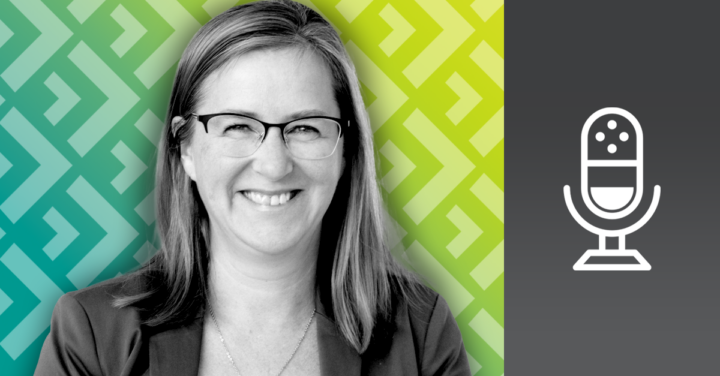
What is actuarial work in the field of workers’ compensation all about? Find out from FCIA Julie Bélanger, actuary at the Commission des normes, de l’équité, de la santé et de la sécurité du travail (CNESST). In this episode, she takes us through her actuarial career, explains her work duties at CNESST and shares her experience in the field of workers’ compensation. She also tells us what makes her passionate about her actuarial work in this organization. Part 2 of this series will cover trends in occupational health and safety (on the pricing and claims side), the impact of the pandemic years, IFRS 17 and much more. This episode is available in French only.
CAN’T LISTEN TO THIS PODCAST? READ THE TRANSCRIPT.
Ayotte: Hello everyone, and welcome to Seeing Beyond Risk, the podcast of the Canadian Institute of Actuaries. My name is Maude Ayotte, and I’m a member of the CIA Communications team at Head Office.
In today’s two-part episode, we’ll be speaking with Julie Bélanger, an FSA and FCIA who works as an actuary for the Commission des normes, de l’équité, de la santé et de la sécurité du travail, or CNESST for short. We’ll be discussing her experience in the workers’ compensation sector.
And so, without further ado, good day, Julie, and thanks for joining us for Part 1 of this episode.
Bélanger: Hello, Maude. Thanks for inviting me to share my experiences.
Ayotte: So, let’s start by introducing the subject. Let’s talk about this organization, CNESST, that you work for as an actuary. Can you tell our listeners what CNESST is all about?
Bélanger: OK, so, CNESST stands for Commission des normes de l’équité, de la santé et de la sécurité du travail. It’s a public organization that encompasses all aspects of labour, and in particular, insurance against workplace accidents and occupational diseases.
Every Quebec employer is insured through CNESST. It’s mandatory, and we have a monopoly on this insurance in Quebec. It’s pretty much the same in all the other provinces too. They all have a workplace safety insurance board.
Ayotte: Can you tell us a little about yourself and the path you’ve taken, and about your role as an actuary at CNESST?
Bélanger: I’ve worked for 24 years as an actuary at CNESST, including 15 as a Fellow. The year I began was when the rating methods were being reformed.
There was a need to train front-line workers – those in contact with the employers – to help them understand the new rating methods so they could in turn explain them to employers. Tools also needed to be developed for them. So that’s how I got my start.
As I gained experience and passed my professional exams, my roles and responsibilities changed. I began to co-manage, with my fellow colleagues, the actuarial valuations required under the Act Respecting Industrial Accidents and Occupational Diseases.
The law states that certain valuations must be carried out by Fellows, particularly for rating but also for valuation of actuarial liabilities. As for me, I work in rating. I’ve worked in rating almost exclusively for my entire career, in fact. I’ve worked a bit with valuations, but not a lot. I have signing authority for rating mode valuations.
Ayotte: CNESST promotes and upholds Quebec workers’ and employers’ employment rights and obligations. What makes working with this organization so exciting for you?
Bélanger: I like working for a public agency with a bit of a social reach. We promote workplace safety and accident prevention.
And while the work I do doesn’t have as obvious an impact as what workplace inspectors do, I still feel I’m making a difference when it comes to employer behaviour. Based on how the rating is done, we can encourage them to engage in prevention and to help injured workers return to the workplace in a timely, sustainable manner. So, we’re encouraging them to do the right thing. And that’s going to reduce their premiums.
We can’t change the rating model a lot because it’s stipulated in the regulations, but we try our best to share the cost equitably among the employers and encourage them to do the right thing.
This also lets us witness first-hand any developments in the workplace. Amendments have been made to the Act. We can share our expertise with others in the agency who focus more on prevention or compensation. I find the diversity of tasks stimulating.
Ayotte: Where does this insurance fit in with the overall insurance market in Quebec?
Bélanger: Workplace safety insurance is mandatory. Every employer with at least one worker has to register with the Commission and pay their insurance premiums. This is like wage insurance, because if a worker is injured and has to take time off, they must be compensated and have their wages paid.
If there’s health insurance as well, because the medical expenses from the workplace accident are paid, the public plan is reimbursed. If the worker is operated on in the hospital, the hospital will bill for this and will be reimbursed, so there’s no cost to the public plan, per se.
There are death benefits as well. In the unfortunate event of a workplace fatality, we are the first payer. If the worker is injured in, say, a road accident and it was in the course of the worker’s duties, it is we – and not the automobile insurer – who will compensate the worker. The work accident has to be a sudden, unexpected event that occurs as a result of or during work. That’s what allows us to say whether or not it’s a workplace accident.
If a worker submits a claim and it’s rejected, normally the person will turn to their salary insurance plan. But otherwise, we’re the ones to pay benefits first. It’s often easier for workers to prove it was a workplace accident. When it comes to occupational disease, it’s sometimes harder to determine if the illness resulted from work.
New occupational diseases have been added to the list of officially recognized diseases. But workers can definitely still try to prove that their illness is linked to their work. But sometimes it’s more difficult.
There’s a movement to add mental health issues and psychosocial risks, but as of yet there aren’t many occupational illnesses or workplace accidents that are accepted for that. But I think this is something that’s going to develop in the future. Recognizing things, like workloads, that can lead to workplace accidents and occupational diseases, that’s an area that’s starting to develop a bit.
Ayotte: And what are the distinguishing characteristics of the Quebec plan in relation to that of the other provinces?
Bélanger: The model is pretty much the same in all the provinces. The insurance is mandatory. What differs is the coverage: not all workers are covered in all the provinces.
There may be certain workers who aren’t in the public realm, for example. The level of coverage can also differ. In Quebec we cover 90% of net salary to an annual insurable maximum. In other provinces it’s less: 85 or 80%. Rating methods differ as well in terms of the funding. It’s always employers who fund the plan, but how the bill is divided can differ from one province to another.
There are various programs in the provinces that can be attached to the insurance. In Quebec, employers fund prevention as well, so there are prevention programs and workplace health services. All of that gets added to their workplace accident premiums.
We also have a program called Pour une maternité sans danger (in French only), which allows the protective reassignment of a pregnant or nursing worker if there is a risk to her or her baby’s health. This program is unique to Quebec, and the costs are passed on to employers.
It’s difficult to compare premium rates among the provinces. We’re trying to do just that in order to see how the various plans operate, but the coverages aren’t always the same, nor are the add-on costs to the insurance premiums.
Ayotte: We have to wrap things up, but what can CNESST’s actuarial analyses tell us about the state of Quebec’s labour market?
Bélanger: The labour market is doing very well, like everywhere else. With the pandemic, we saw a significant increase in the annual maximum insurable salary, what with the lockdowns in the economy. We saw that it was higher-paid workers who continued to work.
Later on there were other wage increases, which have led to strong growth in contributions as well. This has resulted in surpluses, because we hadn’t expected such contributions. And there was no equivalent increase in occupational injuries to go along with this growth in contributions. But occupational injuries have gone up, on account of full employment.
Studies have shown us that… the thinking initially was that young people were more prone to injury at work because they were young, in fact. But we’ve realized that the reason they often sustain workplace injuries is that they’re in a new job.
This is also reflected among experienced workers who return to the labour market in a completely different job than what they had done during their career, or among newcomers who are also starting a job for which they don’t necessarily have the training. This is where the risk of a workplace injury is greatest. This shows us that there’s a lot of employment mobility, and this is where we need to focus our energies when it comes to prevention.
And for sure, inflation has driven up income replacement benefits and led to deficits, but these have been offset by the growth in contributions. Looking at the big picture, we can see that the market is doing well. There are a lot of workers who can return to work. It’s easier after a workplace accident to return to work when you’re wanted, when your employer wants you back to help keep the business running.
Ayotte: That was really interesting. Thanks so much for taking the time to talk with us today, Julie.
Bélanger: Thank you, Maude. It was a pleasure.
Ayotte: And don’t forget to stay tuned for Part 2 of our conversation. We’ll be discussing workplace health and safety trends, rating and claims issues, the impacts of the pandemic these past few years, the IFRS 17 standard and lots more.
Did you enjoy today’s conversation? We invite you to subscribe to our podcast series and catch up on any episodes you may have missed in recent months. And if you have any ideas for a future episode, or you’d like to provide content for our Seeing Beyond Risk blog, please feel free to contact us. Our contact information can be found in the program description.
My name is Maude Ayotte, and I’d like to thank you for listening to Seeing Beyond Risk. Until next time!
This transcript has been edited for clarity.





